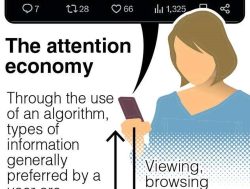Unbalanced Information Diet: Protecting the Facts / Consumers Tricked Into Subscription Contracts Online;Dodgy Merchants Use Small Print, Confusing Language

A woman who cancelled a subscription that her father inadvertently agreed to online shows the shopping website saying, “They intentionally make the cancellation procedure difficult.”
The photo has been partially obscured.
The Yomiuri Shimbun
17:13 JST, April 24, 2024
This is the third installment in a series examining situations in which conventional laws and ethics can no longer be relied on in the digital world, and exploring possible solutions.
***
Shady operators are adept at using tricks called “dark patterns” to manipulate online consumers into making unintended purchases or ensnaring them in unwanted contracts.
In the summer of 2022, a 48-year-old part-time worker in Minami-Alps, Yamanashi Prefecture, was visiting her 80-year-old father nearby when he said, “I want to cancel the contract but I cannot get through on their phone line.” He was upset and irritated, holding his mobile phone in hand.
A few days earlier, he had made an online purchase of a beauty serum advertised as removing skin spots and priced at ¥1,980. He thought it was a one-time purchase. After the first purchase, however, he received an e-mail saying that he had signed a contract for a subscription to the product and that the price was nearly ¥6,000 for the second and subsequent purchases.
The daughter called the vendor’s number on her own smartphone to cancel the subscription on behalf of her father. However, all the calls went straight to voicemail. “The phone line is very busy,” they were told.
So, she switched to the Line app and sent the vendor a message saying that her father wanted to cancel the subscription. Following several exchanges of messages, two options appeared on the screen: One was “Will you really cancel it?” and the other was “Have you decided not to cancel it?”
She chose the first option without hesitation. However, it actually referred to the cancellation of the process to cancel the subscription. So she had to redo the process from the beginning.
The vendor was engaging in “obstruction,” or “making it hard to cancel a service,” which a paper from the Organization for Economic Cooperation and Development lists among several examples of dark patterns.
After that, messages trying to stop her from canceling the subscription appeared one after another, such as: “You will lose all the points after you cancel the subscription.”
This was “nagging,” another example of a dark pattern.
“I was so tired that I almost gave up halfway through,” she said.
After she canceled the subscription, she checked the shopping website and found wording suggesting a subscription purchase. However, the words were written in a much smaller font size than those of the initial price and other advertising phrases.
This fits yet another dark pattern listed by the OECD: “interface interference, e.g. visual prominence of options favourable to the business.”
“Elderly people tend to sign contracts without carefully reading the terms and conditions. This method is unfair and awful,” the Minami-Alps woman said.
The Yomiuri Shimbun asked the vendor for an interview, but they did not respond.
In 2022, consumer affairs centers across the country received a total of about 75,000 complaints and inquiries about “subscriptions” in mail order sales including online sales, increasing 47% from the previous year and reaching a record high number. People 65 and older made about 30% of all inquiries, and nearly 70% of those were about online subscriptions.
But it is not just the elderly who are at risk. Dark patterns could cause consumer trouble for anyone.
Popular Articles
Popular articles in the past 24 hours
-

Santa Claus Delivers Christmas Presents to Penguins at Aquarium i...
-

M5.5 Earthquake Hits Japan’s Aomori and Iwate Prefectures; No Tsu...
-

Earthquake Damage Estimates Report Highlights Challenges Faced by...
-

Outline for Tax System Reform: Put Japan’s Economy on New Growth ...
-

Students Recreate 19th-Century Bento Boxes Made for Ino Tadataka'...
-

My Husband is Extraordinarily Strict with our Daughter, Who is St...
-

U.S. Plans to Stop Recommending Most Childhood Vaccines, Defer to...
-

Hand-Ground, Aroma-Perfecting, Dressed Dishes; 1 Recipe Comes fro...
Popular articles in the past week
-

Israeli Tourists Refused Accommodation at Hotel in Japan’s Nagano...
-

Tsukiji Market Urges Tourists to Avoid Visiting in Year-End
-

China to Impose Sanctions on Shigeru Iwasaki, Former Head of Japa...
-

U.S. Senate Resolution Backs Japan, Condemns China's Pressure
-

Japan to Support Central Asian Logistics Route That Bypasses Russ...
-

Speed Skater Yukino Yoshida Clinches Ticket to Milan
-

Kenta Maeda Joins Rakuten Eagles; Returns from American MLB to Ja...
-

Sharp Decline in Number of Chinese Tourists But Overall Number of...
Popular articles in the past month
-

Keidanren Chairman Yoshinobu Tsutsui Visits Kashiwazaki-Kariwa Nu...
-

Imports of Rare Earths from China Facing Delays, May Be Caused by...
-

University of Tokyo Professor Discusses Japanese Economic Securit...
-

Japan Pulls out of Vietnam Nuclear Project, Complicating Hanoi's ...
-

Govt Aims to Expand NISA Program Lineup, Abolish Age Restriction
-

Blanket Eel Trade Restrictions Rejected
-

Key Japan Labor Group to Seek Pay Scale Hike
-

M4.9 Earthquake Hits Tokyo, Neighboring Prefectures
"Society" POPULAR ARTICLE
-

M4.9 Earthquake Hits Tokyo, Neighboring Prefectures
-

M7.5 Earthquake Hits Northern Japan; Tsunami Waves Observed in Hokkaido, Aomori and Iwate Prefectures
-

Israeli Tourists Refused Accommodation at Hotel in Japan’s Nagano Pref., Prompting Protest by Israeli Embassy and Probe by Prefecture
-

Tsukiji Market Urges Tourists to Avoid Visiting in Year-End
-

M5.7 Earthquake Hits Japan’s Kumamoto Pref., Measuring Upper 5 Intensity, No Tsunami Expected
JN ACCESS RANKING
-

Keidanren Chairman Yoshinobu Tsutsui Visits Kashiwazaki-Kariwa Nuclear Power Plant; Inspects New Emergency Safety System
-

Imports of Rare Earths from China Facing Delays, May Be Caused by Deterioration of Japan-China Relations
-

University of Tokyo Professor Discusses Japanese Economic Security in Interview Ahead of Forum
-

Japan Pulls out of Vietnam Nuclear Project, Complicating Hanoi’s Power Plans
-

Govt Aims to Expand NISA Program Lineup, Abolish Age Restriction





